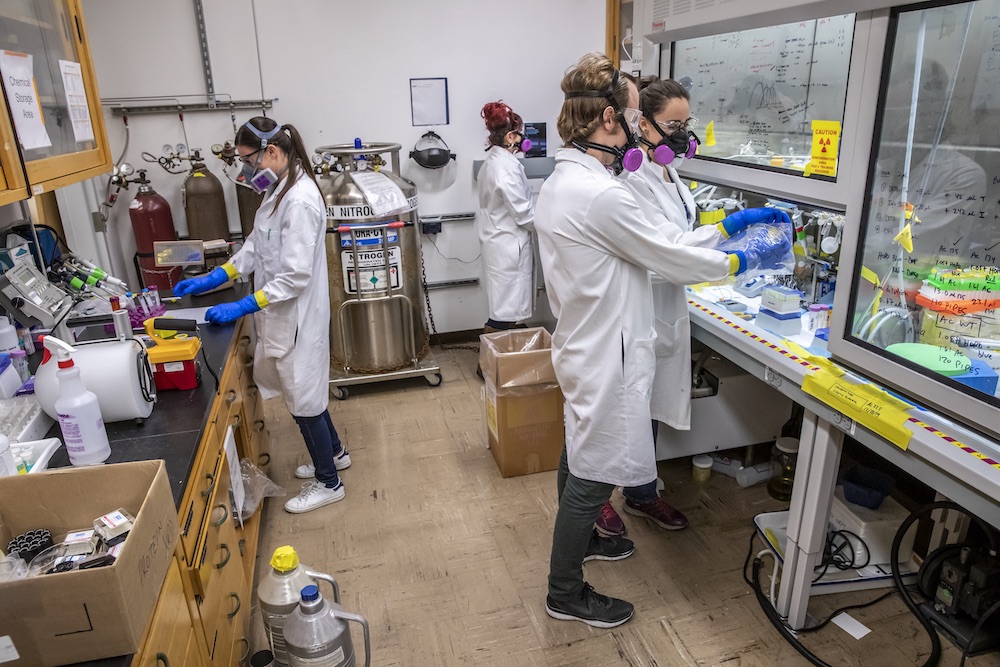This has been adapted from a Berkeley Lab press release.

Since element 99 – einsteinium – was discovered in 1952 at the Department of Energy’s Lawrence Berkeley National Laboratory (Berkeley Lab) from the debris of the first hydrogen bomb, scientists have performed very few experiments with it because it is so hard to create and is exceptionally radioactive. A team of Berkeley Lab chemists has overcome these obstacles to report the first study characterizing some of its properties, opening the door to a better understanding of the remaining transuranic elements of the actinide series.
Published in the journal Nature, the study, “Structural and Spectroscopic Characterization of an Einsteinium Complex,” was co-led by Berkeley Lab scientist Rebecca Abergel and Los Alamos National Laboratory scientist Stosh Kozimor, and included scientists from the two laboratories, UC Berkeley, and Georgetown University, several of whom are graduate students and postdoctoral fellows. With less than 250 nanograms of the element, the team measured the first-ever einsteinium bond distance, a basic property of an element’s interactions with other atoms and molecules.
“There’s not much known about einsteinium,” said Abergel, who leads Berkeley Lab’s Heavy Element Chemistry group and is an assistant professor in UC Berkeley’s Nuclear Engineering department. “It’s a remarkable achievement that we were able to work with this small amount of material and do inorganic chemistry. It’s significant because the more we understand about its chemical behavior, the more we can apply this understanding for the development of new materials or new technologies, not necessarily just with einsteinium, but with the rest of the actinides too. And we can establish trends in the periodic table.”
Abergel and her team used experimental facilities not available decades ago when einsteinium was first discovered – the Molecular Foundry at Berkeley Lab and the Stanford Synchrotron Radiation Lightsource (SSRL) at SLAC National Accelerator Laboratory, both DOE Office of Science user facilities – to conduct luminescence spectroscopy and X-ray absorption spectroscopy experiments.
The research team had to scrap their original plan to use X-ray crystallography – which is considered the gold standard for obtaining structural information on highly radioactive molecules but requires a pure sample of metal – and instead came up with a new way to make samples and leverage element-specific research techniques. Researchers at Los Alamos provided critical assistance in this step by designing a sample holder uniquely suited to the challenges intrinsic to einsteinium.
Then, contending with radioactive decay was another challenge. The Berkeley Lab team conducted their experiments with einsteinium-254, one of the more stable isotopes of the element. It has a half-life of 276 days, which is the time for half of the material to decay. Although the team was able to conduct many of the experiments before the coronavirus pandemic, they had plans for follow-up experiments that got interrupted thanks to pandemic-related shutdowns. By the time they were able to get back into their lab over the summer, most of the sample was gone.
Still, the researchers were able to measure a bond distance with einsteinium and also discovered some physical chemistry behavior that was different from what would be expected from the actinide series, which are the elements on the bottom row of the periodic table.
“Determining the bond distance may not sound interesting, but it’s the first thing you would want to know about how a metal binds to other molecules. What kind of chemical interaction is this element going to have with other atoms and molecules?” Abergel said.
Once scientists have this picture of the atomic arrangement of a molecule that incorporates einsteinium, they can try to find interesting chemical properties and improve understanding of periodic trends. “By getting this piece of data, we gain a better, broader understanding of how the whole actinide series behaves. And in that series, we have elements or isotopes that are useful for nuclear power production or radiopharmaceuticals,” she said.
Read the full press release.

